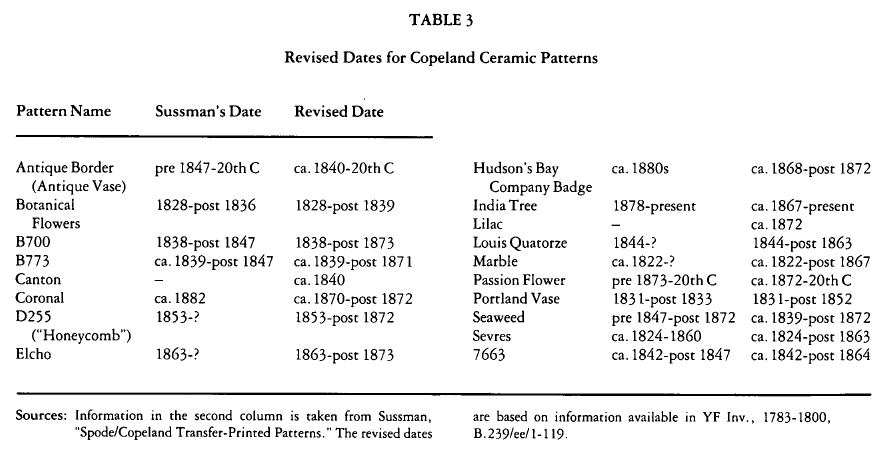Articles
Ceramics Destined for York Factory:
An Examination of Hudson's Bay Company Archival Sources
Abstract
This paper examines the information available in two sets of documents housed in the Hudson's Bay Company Archives. The "York Factory Invoices of Shipments" and the "Indent Books" were studied for details on the ceramic tableware, toilet ware, and containers shipped to York Factory from 1783 to 1880. The names of nine ceramic suppliers and the goods they provided are identified. Information is given on the ceramic shapes, patterns, decorations, and ware types provided by each supplier. The quantity and the price of goods are discussed. The information from the archival records is compared to objects excavated at York Factory. Ceramic shapes produced by W.T. Copeland and Sons and ceramic patterns not previously associated with Hudson's Bay Company sites are illustrated. A glossary of the terminology used in the documents is included.
Résumé
Cet article analyse les données disponibles dans deux séries de documents conservées aux archives de la Compagnie de la Baie d'Huson. À I'aidedes «York Factory Invoices of Shipments» et des «Indent Books», l'auteur apporte des précisions sur la vaisselle, les articles de toilette et les récipients en céramique expédiés à la York Factory de 1783 à 1880 et identifie les noms de neuf fournisseurs de produits céramiques et les articles qu'ils offraient. L'article traite des formes, modèles, décors et genres d'articles céramiques offerts par chaque fournisseur, ainsi que des quantités et des prix. Les renseignements contenus dans les archives sont comparés aux pièces en céramique récupérées lors de fouilles à la York Factory. Pour la première fois, l'auteur associe certaines formes de poteries produites par W. T. Copeland and Sons et certains modèles en céramique aux établissements de la Compagnie de la Baie d'Hudson. Le texte se termine par un glossaire de la terminologie utilisée dans les documents.
1 York Factory, a Hudson's Bay Company post situated near the mouth of the Hayes River in northern Manitoba, was one of the most important fur trade sites in North America. It was occupied almost continuously from 1686 until 1957, when the company closed the post. During those years it had three different locations, involving a total of seven construction periods and numerous structures. At its peak in the 1830s, York Factory had over fifty buildings. During the early 1800s it was both the main supply base for the vast network of posts in northern and western Canada and headquarters of the Hudson's Bay Company's Northern Department. Detailed accounts of all aspects of departmental business were kept, and these records, beginning in 1671, are now housed in the Archives of the Hudson's Bay Company (HBCA) in the Provincial Archives of Manitoba, Winnipeg. Microfilm copies are available at the Public Archives of Canada, Ottawa, and the Public Record Office, London.
2 In 1978 Parks Canada, Prairie Region, began an archaeological investigation at York Factory National Historic Site, and the excavations, conducted during the summer months, are still in progress. Surface indications provide the location of many structures, although only two buildings stand today. One, known as the "Depot," is a three-storey wooden structure built in the 1830s. The excavation programme has recovered a vast quantity of historic artifacts, of which 6,480 are ceramic tableware, toilet ware, and containers dating from the late 1700s to the mid-twentieth century.
3 In an effort to gather more information on the ceramic objects recovered from the York Factory excavations, two sets of Hudson's Bay Company documents were consulted. The information provided by these documents is discussed below and comparison is made to ceramics recovered from excavations at York Factory.
The Archival Sources
4 The "York Factory Invoices of Shipments"1 and the "Indent Books"2 are exceptionally valuable for researchers interested in such aspects of the fur trade as the names of suppliers of goods to Hudson's Bay Company posts, the type of goods requested by company clerks, and the quantity, variety, and price of goods transported to frontier fur trade posts.
5 The "York Factory Invoices of Shipments" were examined for each year from 1783 to 1880.3 They provide a detailed description of the merchandise imported to York Factory for the HBC's Northern Department, an area which included most of the western interior of Canada and all of the western Arctic. Only information on the ceramic orders for York Factory was transcribed, however; orders for all other districts were excluded.
6 The books are set up in column format with the following information recorded from left to right: shipment lot number; quantity and the type of containet the goods were packed in; quantity of item; the item; descriptors such as colour, size, shape, and quality; unit price, and total cost. One example is:
7 From 1823 on, the goods listed are headed by the supplier's name, and the total value of the goods for each supplier is given. Also, the total cost is listed for the containers the goods were packed in, the packing material (straw), and the freight charges from the supplier to the London warehouse. Occasionally there are marginal notations, written by the supplier or the London warehouse clerk, which explain why there were discrepancies between the goods requested and the goods supplied:
8 The first ceramic order of notable quantity was shipped to York Factory in 1796. Prior to this, tableware items were of pewter and tin. After 1872 the quantities of ceramics imported to York Factory decreased considerably. This decrease may simply indicate that the records are incomplete, or it may reflect the decline in importance of the yearly ships from London as transportation from the south developed and the consequent shift in the Hudson's Bay Company headquarters from York Factory to Lower Fort Garry.
9 The "Indent Books" were examined for approximately every fifth year for the period 1801-70. They provide a list of goods ordered (indents) by the Northern Department for the upcoming year. They are set up in much the same format as the invoices of shipments. From left to right they give the quantity of items; a description which generally includes the quality, colour, size, and shape; the item; estimated unit price (based on the previous year's invoices), and the estimated total cost:
10 The information in the "Indent Books" provides a minimum of detail on the ceramics. The descriptive terms, although often vague, suggest that the quality, colour, and decoration of ceramic objects appear to be more important than the ceramic ware type. This provided an interesting insight into how the Hudson's Bay Company clerks perceived ceramic objects.
Ceramics Requested, Supplied and Excavated
11 Most of the ceramics recovered through excavation are English. Packed with straw in casks, they found their way to this Canadian outpost by a long and often dangerous two- to six-week journey by ship from the Hudson's Bay Company's London warehouse. It was customary at the warehouse to receive long lists (the indents) of tableware, toilet ware, and containers requested by the company's clerks for York Factory. These orders, written one to two years prior to receipt of goods, were filled by numerous suppliers as regulated by the Hudson's Bay Company's directors of operations known as the Governor and Committee. The suppliers sent the ordered goods to the London warehouse where they were invoiced and packed for export by ship to York Factory.
12 The clerks requesting ceramics rarely mentioned pattern names but described their wants with such descriptors as: "fine fancy colord ware," "strong colored ware," "Blue figures ware," or "plain white." Interestingly enough, the "H[B]" pattern was the only pattern requested by name. In 1865 a York Factory clerk requested the following items:
12 " ½ [pint] do & saucers
6 oval Dishes 18 Ins.
6 " do 16 "
6 " do 12 "
12 " do vegetable with covers
12 pint Jugs
6 quart do
12 doz. flat dinner Plates
6 " soup " do
6 " flat pudding do
6 " deep do7
These items were shipped from London in 1866 to arrive in York Factory in 1867. The earliest mention of this pattern in the invoices of shipments is recorded in 1868 as being supplied by W . Y . Copeland and Sons:
 Display large image of Figure 1
Display large image of Figure 1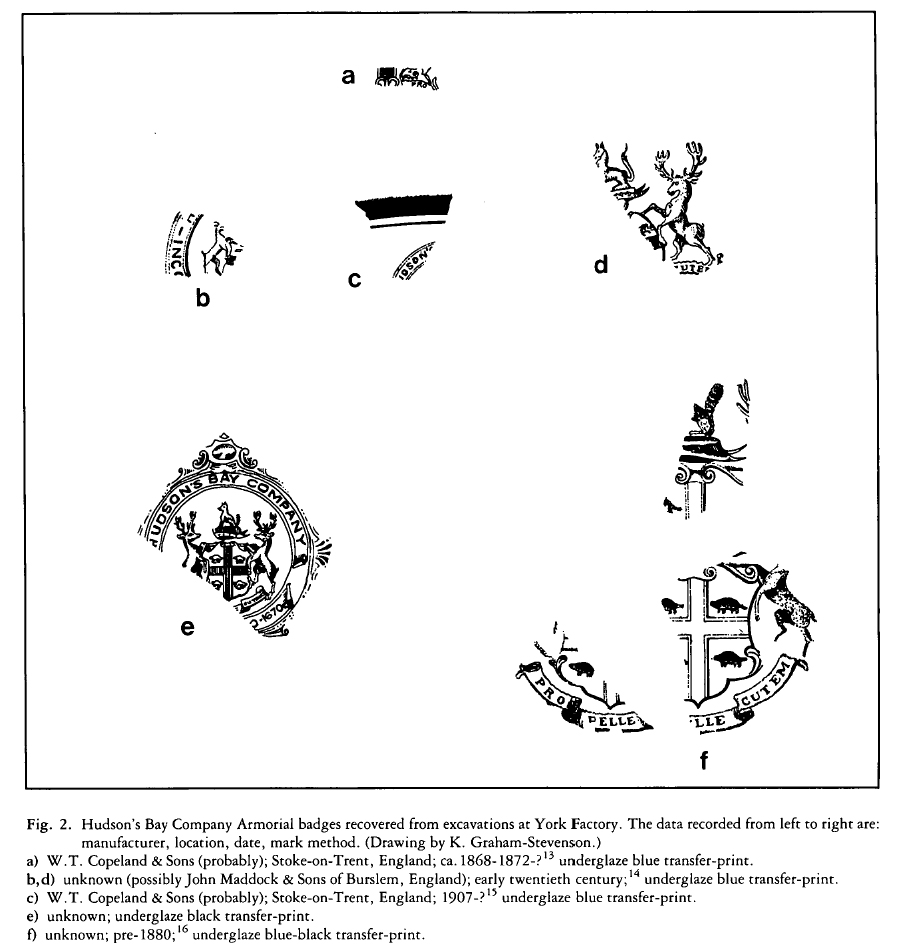 Display large image of Figure 2
Display large image of Figure 213 The excavations at York Factory have recovered one small sherd marked "D255" in blue on the back side and on the front with the HBC Armorial badge. Although this sherd was too small to show the pattern, consultation with factory pattern books revealed that D255 refers to a "honeycomb bead" design (fig. 1). Thirty-seven shards with this design have been found associated with the HBC Armorial Badge. In addition, fragments of five different HBC Armorial badges have been identified (fig. 2). One of these badges was found associated with a pattern other than "D255." The name and manufacturer of this pattern, however, are to date unidentified (fig. 3).
14 These patterns were by no means the only ones at York Factory. The invoices of shipments list some fifty-four different patterns varying in colour and decorating numerous shapes (table 1 and appendix A). They were in blues, "queen's" (violet), brown, "neutral tint" (grey), green, red, and occasionally trimmed with gold. The most popular colour was royal saxon dark blue ("R.S.D.B."). This term was used to describe a particular blue that had "flow" qualities and gave the design a "blurred look," an effect that was popular during the second quarter of the nineteenth century.
15 In the collection of ceramics recovered from the excavations at York Factory there are 314 different pattern/designs produced with such decorative techniques as underglaze transfer-printing, moulded relief, painting, stamping, sponging, lithographing, gilding, slipping, incising, and applying. Transfer-print patterns are by far the most common. Of the transfer-print pattern/designs (177 of which are in blue), most could not be identified as to name or manufacturer, and less than half of the patterns recorded in the archival records were recovered from excavations at York Factory (table 2). It should be noted, how ever, that not all the patterns in the archival records were listed by name. Some were described in general terms which may account for the large number of unidentified patterns in the ceramic collection. Names have been identified for fifty-nine pattern/designs and forty-one of these have been recognized as being manufactured ar the Spode Pottery in England by Spode/Copeland, long noted for its excellent: earthenware and bone china.
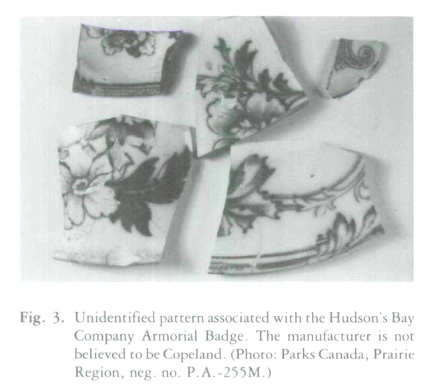 Display large image of Figure 3
Display large image of Figure 316 Spode/Copeland first began supplying ceramics to the HBC in 1836, when William Taylor Copeland worked in partnership with Thomas Garrett and the company was known as Copeland and Garrett (1833-47). In 1847 William T. Copeland went into business for himself and in 1867 his sons joined him to form the company W. T. Copeland and Sons. The company name changed to Spode Limited in 1970 and is still in business today.
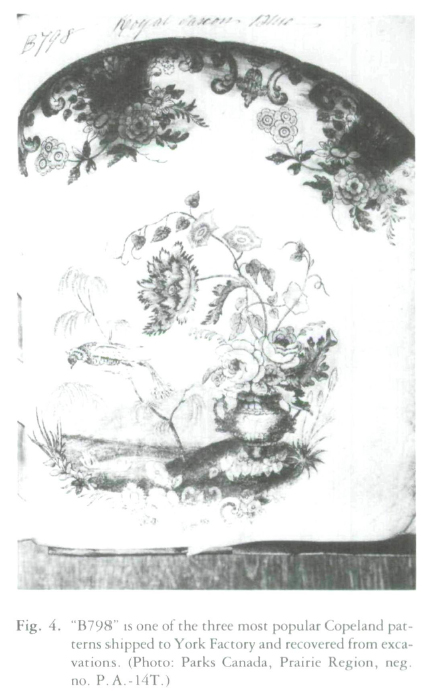 Display large image of Figure 4
Display large image of Figure 417 The most popular of Copeland's patterns, according to the archival records and the excavated examples, were "B700," "B772," and "B798" (later referred to as "Flower Vase") (fig. 4). During the third quarter of the nineteenth century these transfer-print patterns decorated everything from four-quart barrel jugs to soup tureens and ladles to unhandled breakfast cups and saucers (figs. 5-12). Some of the Copeland patterns listed in the archival records have not as yet been excavated. Most of these are a combination of transfer-print, polychrome painting, and gilt decoration and were generally intended for use on bone china objects (figs. 13-29). In addition to these, Copeland's "Lilac," "Canton," and "Ilium" are transfer-print patterns not previously identified as being associated with Hudson's Bay Company sites (figs. 30, 31, 32) and "Grapevine," a pattern for bone china, is illustrated for the first time here (fig. 33).
18 The date ranges for a substantial number of the Copeland patterns have been discussed elsewhere.14 A comparison of these dates to those recorded in the archival records has made possible refinements in the date ranges. These changes are listed in table 3.
19 Not all the ceramics supplied by Copeland were listed by pattern name but some were referred to by the London warehouse clerks as "Printed," "Painted," "Enameled," "Fancy Painted," "Color'd Flowers," and "Painted Roses." These pattern descriptions no doubt refer to some of the Copeland patterns recovered through excavations (table 2).
20 The archival records identify the ceramics as being made of several different ware types. Ceramics supplied by Copeland and Garrett were made of "queensware," "porcelain," "china," or "cream color" and those supplied by W. T. Copeland were made of "P. White," "China," "E'ware," or "Stone" (appendix A). The Copeland ceramics recovered through excavation at York Factory were made of the equivalent ware types known today as white earthenware, pearl ware, or bone china.
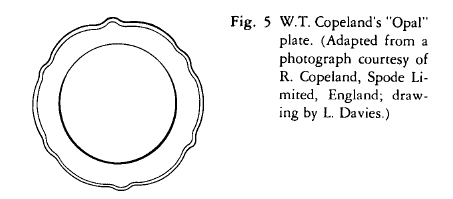 Display large image of Figure 5
Display large image of Figure 5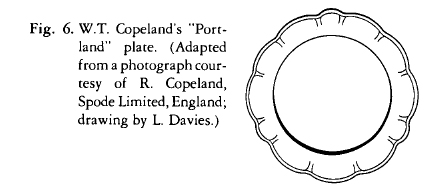 Display large image of Figure 6
Display large image of Figure 6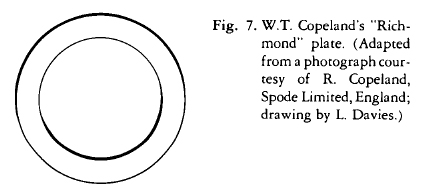 Display large image of Figure 7
Display large image of Figure 7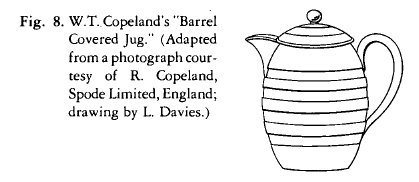 Display large image of Figure 8
Display large image of Figure 8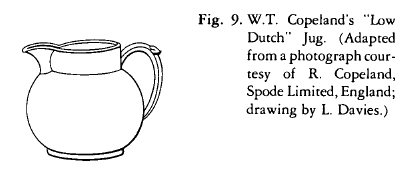 Display large image of Figure 9
Display large image of Figure 9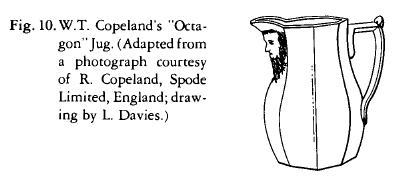 Display large image of Figure 10
Display large image of Figure 10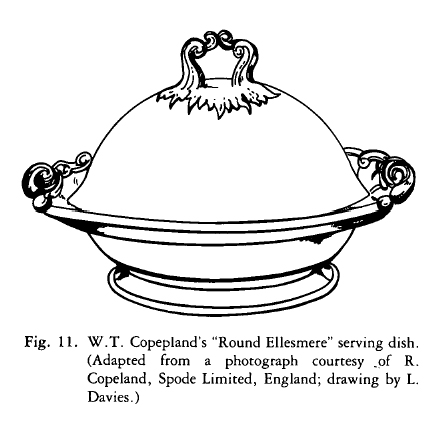 Display large image of Figure 11
Display large image of Figure 11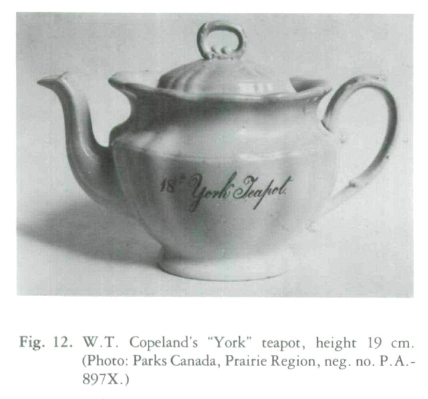 Display large image of Figure 12
Display large image of Figure 1221 The Copeland companies were the sole suppliers of ceramic wares bound for York Factory from 1836 to 1854. Prior to this, Robert Elliott supplied ceramics from 1823 to 1834 and John Blackburn was the supplier in 1835. The Copeland monopoly was interrupted by Boucher and Company from 1855 to 1857, Jonathan Phillips in 1858, W.P. and G. Phillips in 1859, and Boucher, Guy and Company in 1866.
22 Copeland was the only supplier manufacturing ceramics; the remaining six suppliers were china and glass merchants.15 There are no records, to the best of this author's knowledge, which provide listings of the manufacturers of ceramics sent by these china merchants to the HBC. It is difficult, therefore, to identify and match the patterns supplied with a manufacturer. The archival records do, however, provide information on the ware types, colour, patterns, and shapes these merchants supplied.
23 Robert Elliott furnished large quantities of dinnerware, tea ware, toilet ware, and kitchenware similar to the listings for Copeland (table 1). The ceramic items were described as being made of either "queensware" or "earthen ware" and were plain ("white") or decorated with (presumably) transfer-prints in "blue & white," "Best Blue & White," "Foliage," "Red Dot," and "Rich Japan." The latter three descriptions are probably pattern names. "Foliage" was sent in both blue and green, decorating tea ware (table 1). This pattern has not yet been found at York Factory; however, a pattern with the same name is illustrated in Sussman and is likely this design.16 "Red Dot" and "Rich Japan" have not yet been identified.
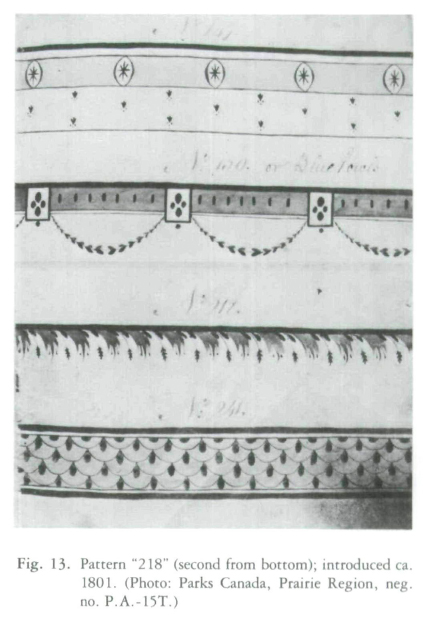 Display large image of Figure 13
Display large image of Figure 13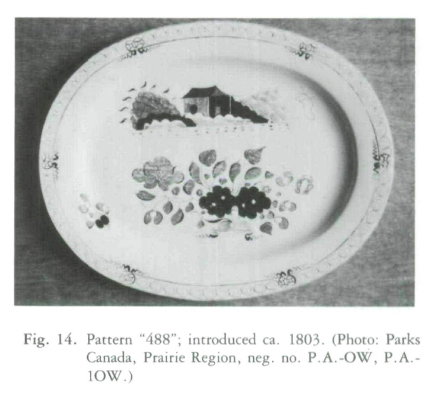 Display large image of Figure 14
Display large image of Figure 1424 J. Blackburn supplied ceramics only in 1835. The majority of the items were toilet ware, but there were also tea ware and dinnerware. These wares were described as being made of "china," "Queensware," and "Brownware." They were decorated in "blue & white," "best green & white," "fine china painted," "Neat Marble," and "New Pattern." Exactly what patterns these descriptions refer to is not known. Because both Blackburn and Elliott were china merchants, it is possible they were supplying Spode/Copeland ceramic patterns along with other manufacturers' ceramics.
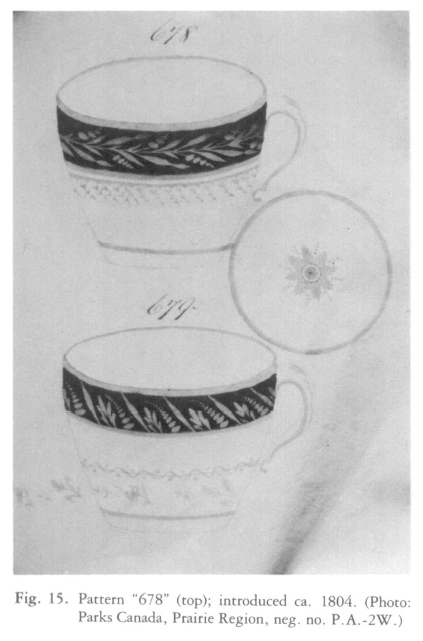 Display large image of Figure 15
Display large image of Figure 15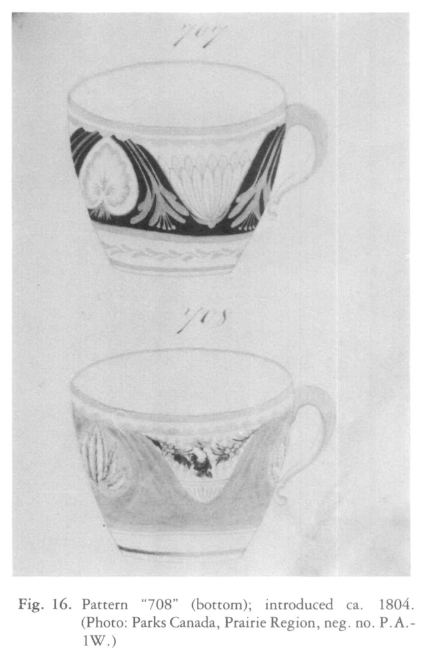 Display large image of Figure 16
Display large image of Figure 1625 Boucher and Company, later known as Bouchet, Guy and Company, supplied a limited number and variety of ceramic shapes. Most were plates of various types, but there were also tea ware, serving ware, and gallipots. Descriptions were not given for the ware types and the decorations on these items.
26 Jonathan Phillips and W.P. and G. Phillips supplied only bowls, saucers, mugs, and plates. The wares of the latter were described as being decorated in "blue," "printed," and the pattern "Fibre" (table 1). This pattern was produced by several British manufacturers including Copeland. Excavated examples from York Factory are in both blue and green but unfortunately not enough of the sherds are present to identify a manufacturer's name.
27 The orders of ceramics supplied by these companies varied in quantities and variety from year to year and were by no means meagre. The quantities of items ranged from a single item to 30 dozen, but generally there were at least 8 dozen of any one shape. The largest total order in a single year (314 dozen) was supplied in 1869 by W.T. Copeland and Sons (table 4). W.T. Copeland supplied on the average the largest quantities and varieties of ceramic goods overall.
28 The prices of goods generally remained constant during the period of supply for each of the nine suppliers. Prices did change from company to company, particularly in the post-1850 years when Copeland, Phillips, and Boucher were in competition. In 1855, for example, W.T. Copeland reduced its prices for such items as blue printed cups and saucers from four shillings to three shillings ten pence per dozen and it reduced blue printed ten-inch plates from four shillings to three shillings and then to two shillings three pence. Copeland's prices undercut Boucher by three pence per dozen for mugs and by one shilling two pence for cups and saucers. In the 1870s, when W.T. Copeland and Sons was the sole supplier, the prices of most goods were inflated. This price increase may have reflected a rising cost of production or more probably the lack of competition at this time.
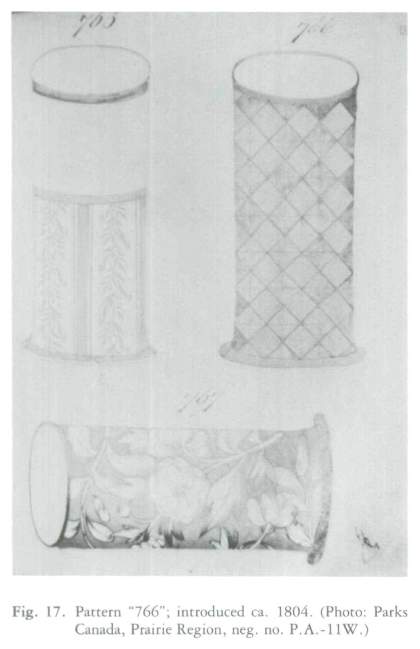 Display large image of Figure 17
Display large image of Figure 17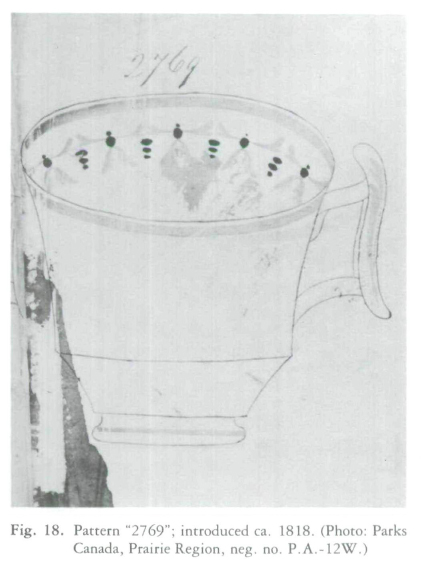 Display large image of Figure 18
Display large image of Figure 18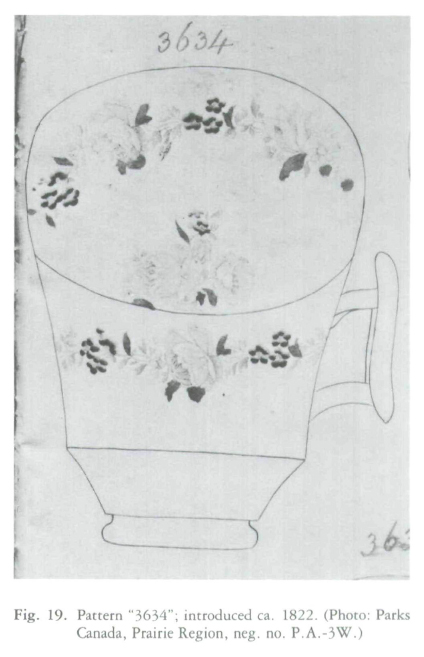 Display large image of Figure 19
Display large image of Figure 1929 The prices of objects varied, depending on the decoration and ware type. Objects of china with painted decoration were generally fifteen shillings to two pounds more per dozen than a blue printed object of the same shape. Most ceramic patterns described as being "blue & white" (decorated with a blue transfer-print pattern) cost the same for any one supplier. Only one blue pattern cost less. W . T . Copeland and Sons' "Shamrock" pattern on a ten-inch plate was two pence less than most of Copeland's other blue printed patterns. Patterns were higher in price if they were in colours other than blue. Elliott's patterns "Green Foliage" and "Red Dot" in 1834 were one shilling more per dozen than the same objects in "blue and white. " The cost of objects without decoration was one shilling four pence to two shillings four pence less than the cost of objects decorated with blue printed patterns.
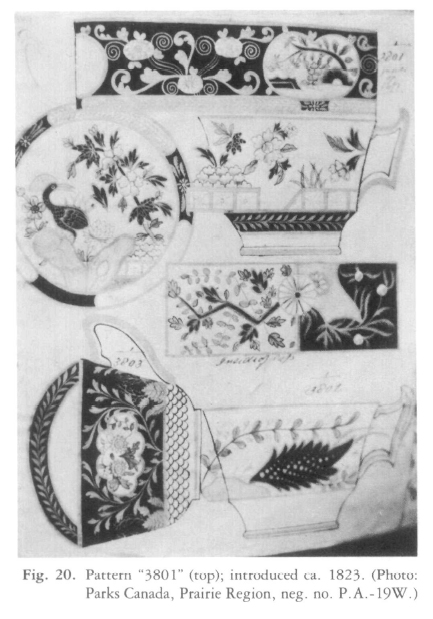 Display large image of Figure 20
Display large image of Figure 20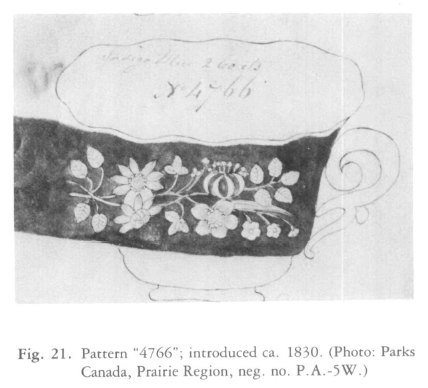 Display large image of Figure 21
Display large image of Figure 21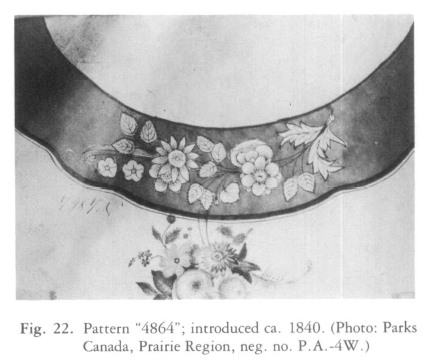 Display large image of Figure 22
Display large image of Figure 22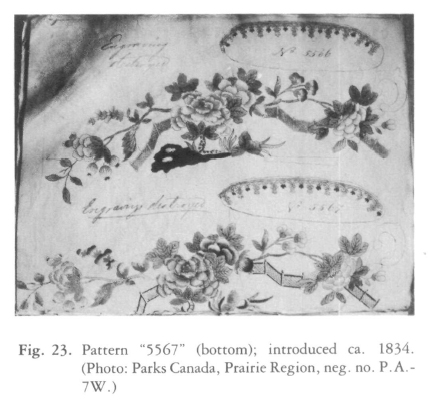 Display large image of Figure 23
Display large image of Figure 2330 Most of the information on ceramics provided by the archival records concurred with what has been found archaeologically. Of notable interest was the wide variety of patterns. Both the archival records and the excavated examples reflect this, although the variety of patterns for each is slightly different.
31 Two notable but not surprising discrepancies between the information provided by these two sources were the variety of ceramic shapes and the numbers of ceramic objects. Only the basic shapes recorded in the archival records have been identified in the recovered ceramic collection. This was largely attributed to the difficulty in identifying specific shapes from small sherds, particularly (as suggested by the archival records) when the difference between shapes was generally a difference in size (table 1). The vast numbers of ceramics shipped to York Factory have not been reflected by the recovered ceramics. An obvious explanation was simply that not all the areas of discard had been excavated (only about 1 per cent of the site has been dug) and that some of the objects were transported for trade inland.
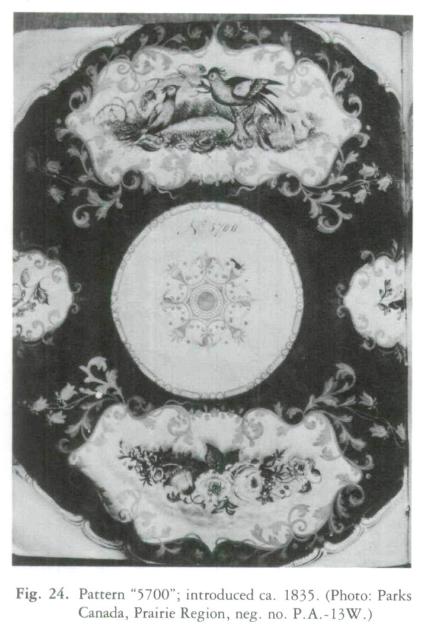 Display large image of Figure 24
Display large image of Figure 24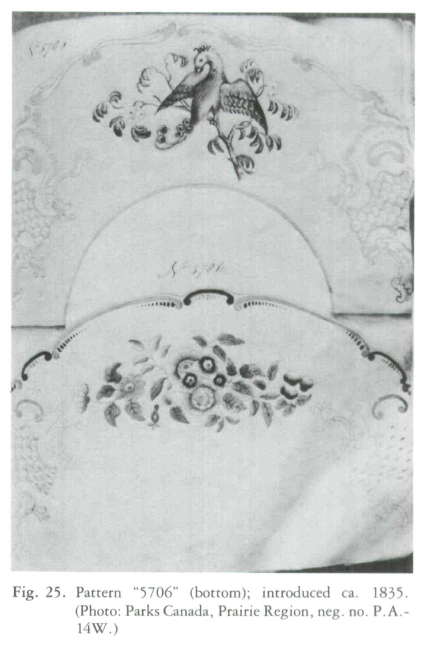 Display large image of Figure 25
Display large image of Figure 25 Display large image of Figure 26
Display large image of Figure 26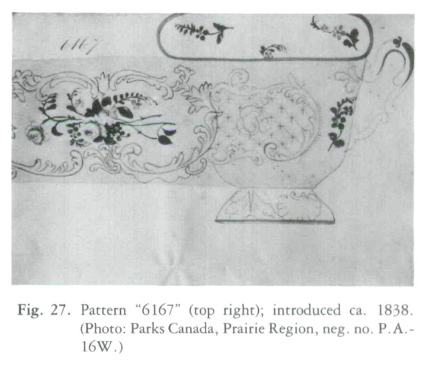 Display large image of Figure 27
Display large image of Figure 27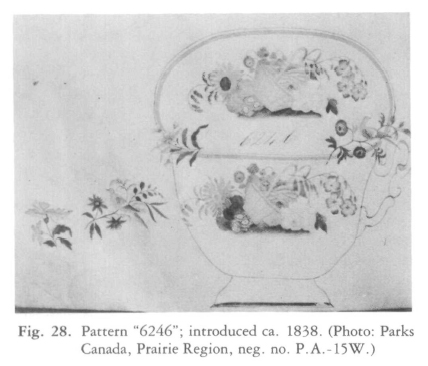 Display large image of Figure 28
Display large image of Figure 28 Display large image of Figure 29
Display large image of Figure 29 Display large image of Figure 30
Display large image of Figure 30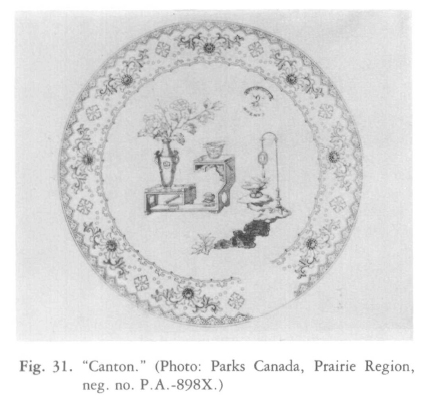 Display large image of Figure 31
Display large image of Figure 31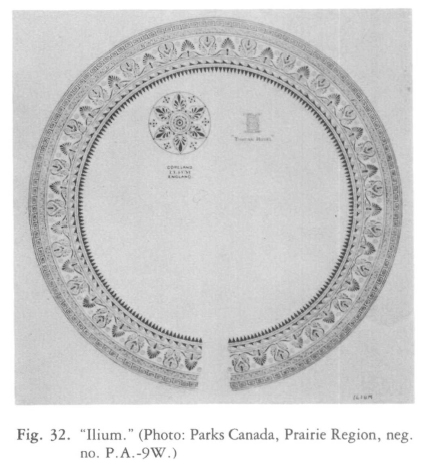 Display large image of Figure 32
Display large image of Figure 32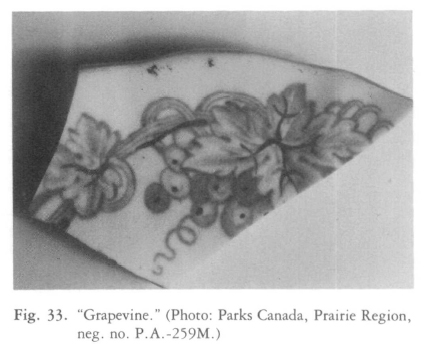 Display large image of Figure 33
Display large image of Figure 3332 The HBC archival records have provided a great deal of valuable information on ceramic suppliers and their wares. They have supported and challenged archaeological data and have provided incentive for future research. Clearly, during the nineteenth century there was no scrimping by the company on the quantities and varieties of ceramics made available to frontier settlements. Consequently, there is today no scrimping on the availability of archival records for researchers' scrutiny.
 Display large image of Table 2
Display large image of Table 2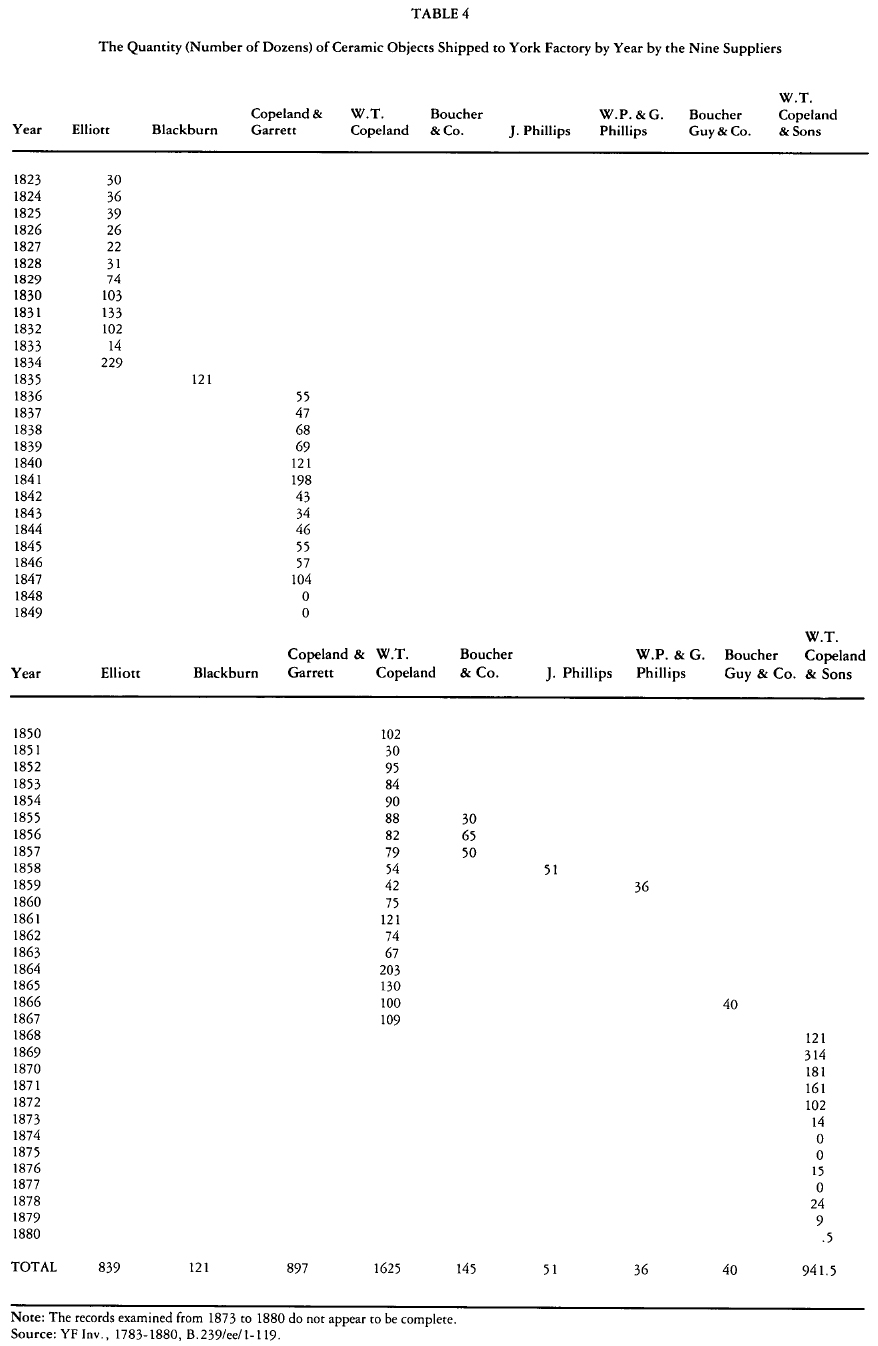 Display large image of Table 4
Display large image of Table 4APPENDIX A A Glossary of the Terminology used in the "York Factory Invoices of Shipments" Records
A Copeland shape name. Describes "jugs" of 1-and 4-gallon capacity and is listed in the HBC records from 1858 to 1862 (fig. 8).
A concave vessel, varying in size, for holding water for washing or for mixing food. Most basins sent to York Factory were "wash hand basins," or "saucers and basins." (Also see slop-basin and basin and saucer.)
See breakfast cup and saucer.
A small bowl holding up to a pint. It was part of a tea service and was used to hold sugar or the dregs from the cups. (See slop-basin.) Also, an older spelling of basin (see basin, and basin and saucer).
Breakfast. See breakfast cups and breakfast bowls.
See breakfast cup and saucer.
See breakfast cup and saucer.
A cup that is considerably greater in capacity than a tea cup. The cups sent to York Factory were generally unhandled and of ½-pint or ¾-pint capacity. The matching saucer is more similar to a shallow bowl than to a modern saucer. The "breakfast bowls," "breakfast saucers," and possibly the "basins and saucers" are the same shape as the "breakfast cup and saucer."
Brown earthenware. Describes "milk dishes" and "milk pans" supplied by R. Elliott in 1823 and 1834 and by J. Blackburn in 1835.
This function has not been identified. Possibly refers to a tea canister. The records indicate it cost Is. 6d., the same as a sauce tureen and ladle.
Chamber pot, a vessel for urine. They were supplied in a number of sizes and in Copeland's "Douro" and "Flat Rim" shapes.
Bone china.
Complete. Often used in association with a soup or sauce tureen and indicates the lid, ladle, and stand are included.
Decorated. Used to describe "bowls and breakfast saucers."
Platters or covered serving dishes. They are listed as being 10, 12, 16, and 18 inches.
A Copeland shape name. Describes "hand bowls," "chambers," "bowls and breakfast saucers" from 1867 to 1870.
Possibly an abbreviation for durable or the shape name "Douro." Describes "unhandled breakfast cups and saucers," "bowls and breakfast saucers," and "hand bowls" from 1860 to 1865.
Possibly an abbreviation for durable or the shape name "Douro-" Describes "bowls and saucers" and "jugs, from 1869 to 1872.
An abbreviation for the Copeland shape "Elles-mere." Describes "cover dishes" in 1868 (fig. 11).
Painted over the glaze.
Earthenware.
This may refer to a Barber's bowl, a deep wide-rimmed circular bowl with an indentation in the rim which could be fitted snugly under the chin of the person being shaved.
A Copeland shape name. Describes "chambers" in 1851, 1861 and "hand bowls" in 1851-52.
The numbers are part of a system of size used for hollow-ware objects. They refer to the total number of objects sold in a dozen and indicate the size of the object. The system is based on the size of a 1-pint mug. A 1-pint mug counts 12 (12s.) to the dozen. If the object contains more, there are less to the dozen ("4s hand bowls" indicates there are 4 hand bowls of 3-pint capacity to the dozen) and if they contain less there are more to the dozen ("24s bowls" indicates there are 24 bowls of ½-pint capacity to the dozen). These sizes formed the basis for price scales. Flatware objects were priced according to their size in inches ("10 in. plates," "8 ½ in. plates," etc.).
A small pot used to hold medicines, ointment, etc., and having a lip at the rim for securing the closure. They were shipped to York Factory in 1-, 2-, 3-, and 4-ounce capacities by Copeland and Garrett, W.T. Copeland, and Boucher & Co. Excavated examples are made of homogeneous white salt-glazed stoneware and cream ware.
Probably another name for a sauce tureen. They were in 16, 18, and 24 inch sizes, suggesting a shape larger than a gravy or sauce boat.
This function has not been identified. They were in 7 and 9 inch sizes.
Pitcher. They were supplied in 1-pint, 1-quart, 2-quart, and 1-gallon capacities from 1823 to 1880.
This abbreviation has not been identified.
A Copeland shape name. Describes "jugs" of 1-pint and 3-quart capacity in 1850 and 1866 (fig. 9).
Probably a Copeland shape name. Describes "30[s] Mugs" in 1869.
A dark blue underglaze ground colour.
A Copeland shape name. Describes "hand bowls" in 1851.
Large wide shallow bowls. They were shipped to York Factory in three sizes and were made of "brown earthenware."
("n. tint") A light grey colour.
Hudson's Bay Company's number code for W.T. Copeland & Sons.
Hudson's Bay Company number code for a company as yet unidentified (possibly Boucher, Guy & Co.).
An abbreviation for octagonal or the Copeland shape "Octagon."
A Copeland shape name. Describe "jugs" of 1-pint, 1-quart, 2-quart, and 1-gallon capacity, from 1850 to 1867 (fig. 10).
A Copeland shape name. Describes 10-inch plates from 1863 to 1866 (fig. 5).
A Copeland shape name. Describes teapot in 1858.
Pearl White.
Plates sent to York Factory were in 8 '/2-inch and 10-inch sizes. They included soup, flat, dessert, pudding, and pie plates.
A Copeland shape name describing "chambers" in 1850.
A Copeland shape name. Describes plates and dishes from 1850 to 1852 (fig. 6).
Violet colour. (This interpretation is based on a comparison of excavated examples of patterns to the patterns recorded in the HBC records as being this colour.)
1. A cream-coloured lead-glazed earthenware developed by Josiah Wedgwood in the 1760s. Following the patronage by Queen Charlotte it became known as "Queen's ware. " More commonly referred to as cream ware.
2. A term used to describe an undecorated ceramic shape.
A Copeland shape name. Describes "plates" in 1863 (fig. 7).
A Copeland shape name. It is probably similar to the "Royal" plate shape.
(R.S. dark blue, saxon blue) An abbreviation for royal saxon dark blue. A dark vivid blue which has flow qualities and gave a blurred look to the pattern.
The meaning is not as yet clear. Possibly refers to smalt blue (a deep blue pigment) or slight blue.
It was part of a tea service and was used at the table to hold the dregs or for rinsing the tea cups. (See basin.)
A soup plate has a deep depression in the centre and a wide rim.
Stoneware. Describes bottles and jars supplied by Copeland & Garrett from 1840 to 1847 ("4 Gall Stone Jars 6 in. Dia. & Bungs," "2 Qt. & Qt. jars," "Quart stone bottles") and by W.T. Copeland from 1850 to 1864 ("Upright Stone Jars," "4 Gall. 6 in. Diam of Opening, cork stoppers," "Qt Stone Ale Bottles").
"York" is a Copeland shape name for teapots. They were shipped to York Factory from 1850 to 1855 (fig. 12).

